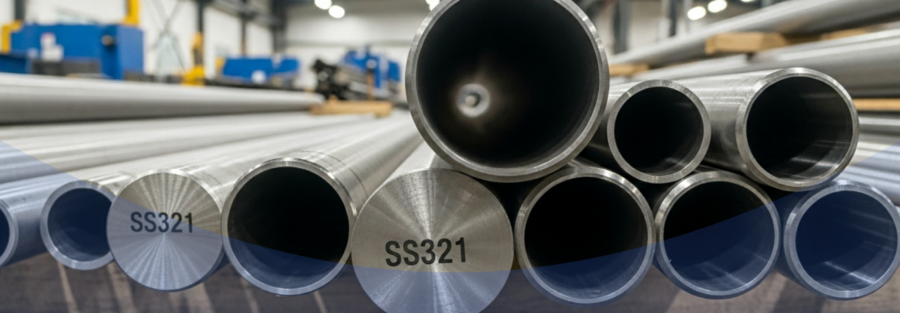Table of Contents
1. Introduction
Stainless Steel 321 is a titanium-stabilized austenitic alloy widely used for its exceptional heat resistance, durability, and corrosion protection. Known as an upgrade over SS 304, this grade performs reliably in high-temperature environments, making it a preferred choice for industries like aerospace, petrochemicals, and power generation. In this guide, we’ll explore the properties, composition, applications, and benefits of Stainless Steel 321, along with how it compares to other popular grades.
2. What is Stainless Steel 321?
Stainless Steel 321 is an austenitic stainless steel alloy stabilized with titanium. This stabilization helps prevent carbide precipitation during welding, making it more resistant to intergranular corrosion.
It is widely recognized as a high-temperature material that offers excellent strength, durability, and resistance to oxidation, especially in environments where exposure goes beyond 800°C.
In simple terms, SS 321 is like stainless steel 304, but with added titanium for better heat resistance and weldability.
3. Stainless Steel 321 Chemical Composition
| Element | Percentage (%) |
|---|---|
| Carbon (C) | ≤ 0.08 |
| Chromium (Cr) | 17.0 – 19.0 |
| Nickel (Ni) | 9.0 – 12.0 |
| Titanium (Ti) | ≥ 5 × C% (min 0.7%) |
| Manganese (Mn) | ≤ 2.0 |
| Silicon (Si) | ≤ 1.0 |
| Phosphorus (P) | ≤ 0.045 |
| Sulfur (S) | ≤ 0.03 |
| Iron (Fe) | Balance |
4. Key Mechanical Properties of SS 321
| Property | Value |
|---|---|
| Density | 8.0 g/cm³ |
| Melting Point | 1398–1454 °C |
| Tensile Strength | 515 MPa (min) |
| Yield Strength | 205 MPa (min) |
| Elongation | 40% (min) |
| Hardness | 217 HB (max) |
5. Stainless Steel 321 vs 316: Which Should You Choose?
| Feature | SS 321 | SS 316 |
|---|---|---|
| Stabilizer | Titanium | Molybdenum |
| Heat Resistance | Excellent (up to 870°C) | Moderate (up to 600°C) |
| Corrosion Resistance | Good | Excellent in chlorides & acids |
| Weldability | High | High |
| Applications | Heat exchangers, aerospace, furnaces | Marine, chemical plants, pharma |
- Choose SS 321 if you need high-temperature resistance.
- Choose SS 316 if your environment involves chlorides, seawater, or harsh chemicals.
6. Applications of Stainless Steel 321
Stainless Steel 321 is widely used in industries such as:
- Aerospace – exhaust manifolds, jet engine parts.
- Petrochemical – refinery equipment, piping.
- Power Generation – boilers, heat exchangers.
- Food Processing – high-temperature sterilizers.
- Automotive – exhaust systems.
- Furnace Parts – radiant tubes, conveyor belts.
Its ability to maintain strength even at 870°C makes it unique among stainless steel grades.
7. Benefits of Using SS 321 in Industries
- High Temperature Strength – retains toughness at elevated temperatures.
- Excellent Corrosion Resistance – resists oxidation and scaling.
- Improved Weldability – titanium prevents carbide precipitation.
- Durable and Long-lasting – reduces maintenance costs.
- Versatile Applications – from aerospace to food-grade equipment.
Stainless Steel 321 stands out as a heat-resistant, corrosion-resistant, and durable alloy suitable for demanding industrial environments. Whether you’re in aerospace, petrochemical, or power generation, SS 321 ensures performance and reliability.
At Riyaarth Overseas, we supply premium-quality Stainless Steel 321 sheets, plates, pipes, and fittings that meet global standards. Get in touch with us today to source materials that match your exact requirements.
8. FAQs
SS 304 is the most common stainless steel, but SS 321 contains titanium, making it more resistant to heat and intergranular corrosion.
No, SS 321 is generally non-magnetic in the annealed condition, though slight magnetism may appear after cold working.
While it resists corrosion, SS 316 is a better option for chloride or saltwater-rich environments.
SS 321 can handle continuous exposure up to 870°C and intermittent exposure up to 925°C.

